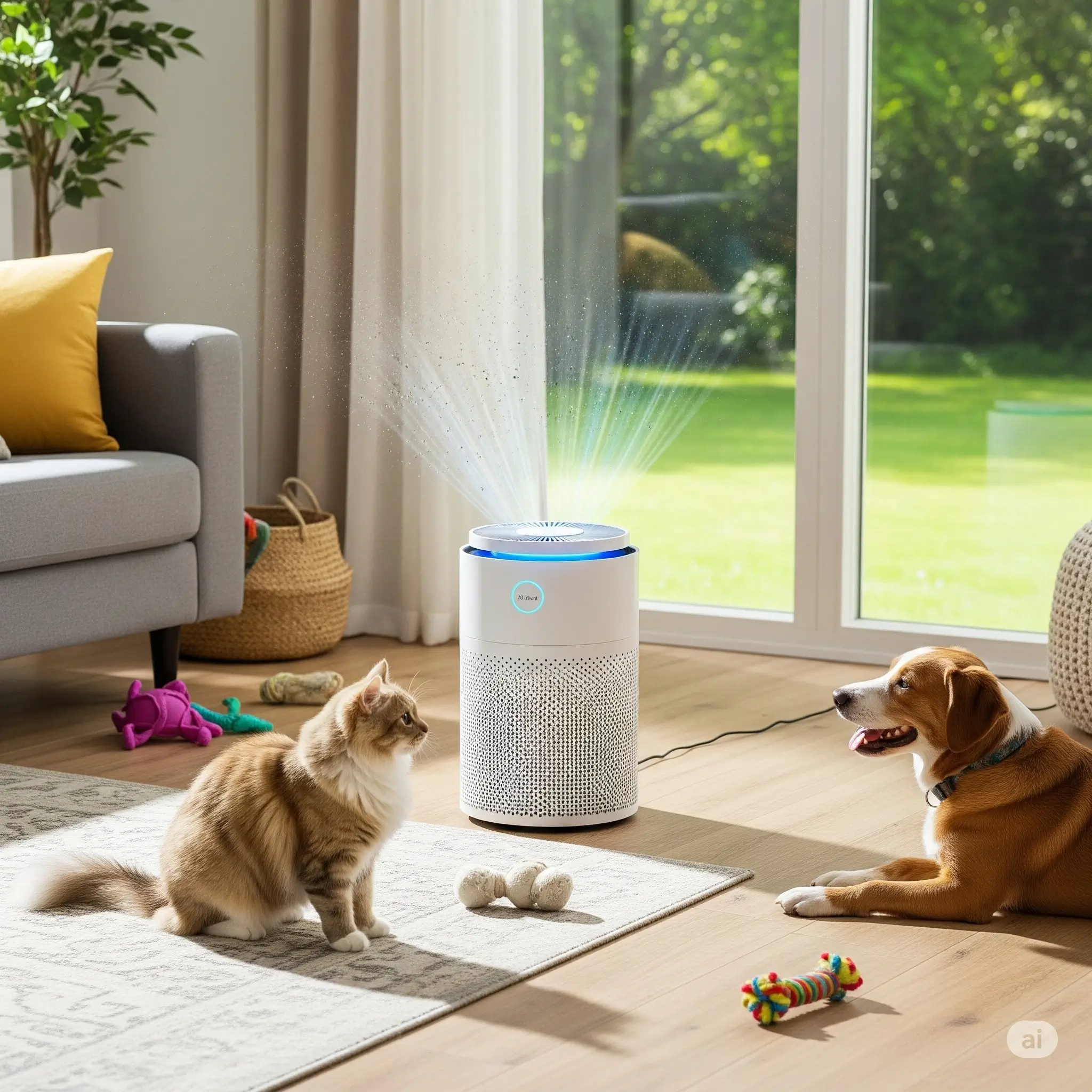Bringing a new baby home is exciting, but it also means thinking about all the little things that can affect their health. One of those things is the air they breathe. Babies are more sensitive, and the air inside our homes can have stuff we can’t even see, like dust or tiny particles from cooking. So, choosing the best air purifier for newborn is a good idea. We’ve looked into what makes a good one, focusing on things like filters, noise, and what extra features might be helpful. We even tested some out to see how they really perform. Let’s figure out how to get the cleanest air for your little one.
Key Takeaways
• When picking an air purifier for infants, look for HEPA filters. They’re really good at catching small particles that can bother little lungs.
• Noise matters. Babies need quiet to sleep, so aim for a purifier that’s not too loud, especially on its lower settings. Think 50 decibels or less.
• Some purifiers have nice extras like nightlights or apps that let you check air quality from your phone. These can be handy, but the main job is cleaning the air inside your air purifier for baby room.
• Filter life and how often you need to replace them will affect the yearly cost, so keep that in mind when you’re budgeting.
• The Levoit Core 300S is a solid choice overall, and if quiet operation is your top priority, the Rabbit Air BioGS 2.0 is a strong contender.

What Is A HEPA Filter?
When you’re looking for an air purifier for newborn, especially for a new baby’s room, you’ll see the term “HEPA filter” a lot. But what does it actually mean? Basically, a HEPA filter is designed to catch really tiny particles from the air.
The “true HEPA” standard, at least in North America, means the filter has to capture at least 99.97% of particles that are 0.3 microns in size. Think about how small that is a, human hair is usually between 20 and 180 microns wide. It might seem odd, but particles that are even smaller or larger than 0.3 microns are often caught even more easily by these filters.
There’s also a European standard, often called “medical grade” or H13, which is very similar. It requires capturing 99.95% of the most difficult to catch particles. So, when you see “HEPA” or “true HEPA” on a product, it’s a good sign that it’s built to a high standard for cleaning the air in your air purifier for nursery.
Here’s a quick breakdown of what HEPA filtration aims to do:
- Capture fine particles: This includes things like dust, pollen, pet dander, and mold spores.
- Trap microscopic irritants: It’s effective against bacteria and some viruses.
- Reduce allergens: For families with allergy concerns, this is a big plus.
Filters labeled “HEPA-like” or “HEPA-type” may sound official, but they are not held to the same rigorous standards as true HEPA filters. It’s always best to look for “true HEPA” or a filter that meets the H13 standard for the best air cleaning performance.
Understanding CADR Ratings
When you’re looking at air purifiers for newborn, you’ll see something called CADR, which stands for Clean Air Delivery Rate. Think of it as the speed limit for how fast a purifier can clean the air in a room. It’s a rating set by the Association of Home Appliance Manufacturers (AHAM) that tells you how quickly a unit can remove common pollutants like dust, smoke, and pollen.
Basically, the higher the CADR number for each pollutant, the faster the purifier works. It’s a pretty straightforward way to compare how effective different machines are at clearing the air. For example, a purifier with a higher smoke CADR will clear smoky air more quickly than one with a lower rating.
Here’s a quick breakdown:
- Dust CADR: Measures how fast the purifier removes dust particles.
- Smoke CADR: Indicates how quickly it cleans smoke, which is great for dealing with cooking smells or wildfire haze.
- Pollen CADR: Shows its speed in removing pollen, a big plus for allergy sufferers.
A simple guideline: choose an air purifier whose CADR for each pollutant is roughly two-thirds of the room’s square footage for a 150 sq ft space, aim for a CADR of about 100. This helps make sure the purifier is powerful enough to do a good job without running constantly on its highest, loudest setting.

It’s not the only thing to consider, of course, but it’s a really solid starting point for figuring out if a purifier can actually handle the size of the room you need it for
Noise Levels and Decibels
When you’re choosing an air purifier for newborn, the noise level is a big deal. Nobody wants a loud machine constantly humming or whirring, especially when trying to get a baby to sleep. You’ll want to strike a balance, strong enough to clean the air, yet quiet enough to keep the room comfortable.
Most air purifiers will list their decibel (dB) ratings. For a nursery, you’ll want to aim for a unit that operates at a lower decibel level, ideally below 50 dB, especially on its lower settings. Some units are designed to be whisper quiet, operating around 20-30 dB on their lowest fan speeds, which is barely noticeable. Others might be a bit louder, but still acceptable if they have a very quiet low setting. It’s good to check the specs for different fan speeds, as the noise level can change significantly.
Here’s a general idea of what different decibel levels mean:
- 0-30 dB: Very quiet, like a whisper or rustling leaves. Perfect for a nursery.
- 30-50 dB: Quiet, comparable to a library or quiet conversation. Still good for sleep.
- 50-60 dB: Noticeable, like a normal conversation or a refrigerator. Might be too loud for some babies.
- 60+ dB: Comparable to the roar of a vacuum or the clamor of a bustling street noticeably loud. Definitely too disruptive for a nursery.
When looking at noise levels, remember that the highest setting is often the loudest, but you’ll likely use lower settings for daily operation. Always check the decibel rating for the lowest fan speed to gauge its suitability for nighttime use.
Some purifiers also offer a “sleep mode” or “night mode” which automatically lowers the fan speed and dims or turns off the lights, making them even more suitable for a baby’s room. It’s worth checking out models that offer this feature, as it can make a big difference in maintaining a peaceful environment. For example, some units can operate at a very low 40.9 dB on their first speed, which is quite acceptable for a baby’s room quiet operation.
When comparing models, look for specific noise level data for each fan speed. This will give you a clearer picture of how the purifier will perform in your baby’s room throughout the day and night.
Air Quality Indicators
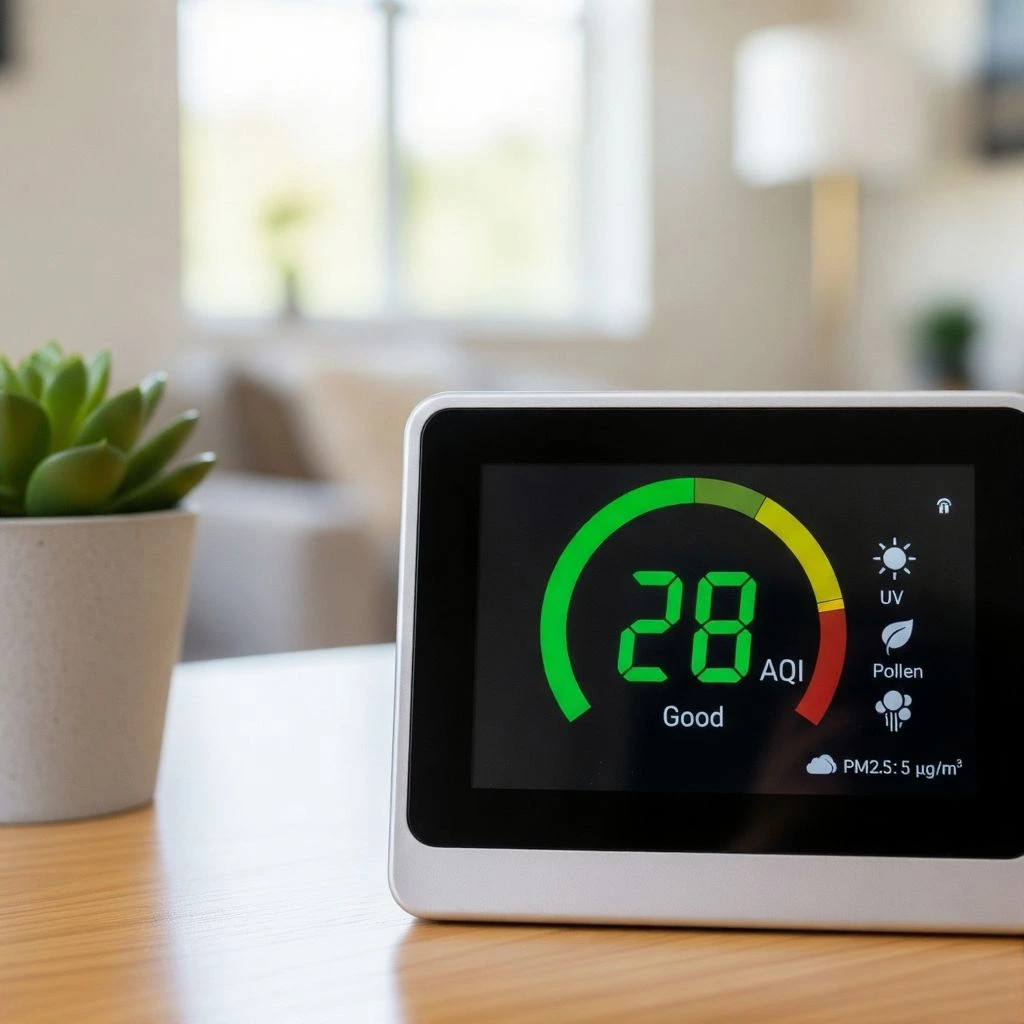
Some air purifiers for newborn come with built in sensors that can actually tell you what the air quality is like in the room. It’s pretty neat, honestly. You’ll often see a color coded light on the unit itself, or maybe a display that shows a number.
- Green: Usually means the air is good.
- Yellow/Orange: Indicates moderate pollution.
- Red: Signals poor air quality.
This feature is super helpful because it takes the guesswork out of whether your purifier is actually doing its job. You can see at a glance if something has kicked up dust or if there’s an odor lingering. Some of the fancier models even connect to an app on your phone and give you a detailed breakdown of the air quality, showing you the levels of different particle sizes.
It’s like having a little weather report for your air, letting you know if it’s a clear day or if you might need to crank up the purifier a bit more. This real-time feedback is a big plus when you’re trying to keep the air in your air purifier for baby nursery as clean as possible.
Child Lock Features
When you have a little one crawling around, safety is always top of mind. Many air purifiers for newborn come with a child lock feature, and it’s a really smart addition, especially if you’ve got a curious toddler who likes to push buttons.
This simple lock prevents accidental changes to the purifier’s settings, stopping your child from turning it off, changing the fan speed, or messing with other functions. It’s a small thing, but it can save you a lot of hassle and keep the purifier running as intended. Some models even hide the control panel or have a specific button combination to activate the lock, making it harder for little fingers to discover.
Here’s why it’s a good idea to look for this feature:
- Prevents unintended adjustments: Stops your child from turning the unit off or changing modes.
- Boosts safety: makes it harder for kids to interfere with the purifier.
- Peace of mind: Lets you run the purifier without constant supervision.
Some purifiers, like the Levoit Core 300S and the Rabbit Air BioGS 2.0, specifically mention this feature as a benefit for families with young children. It’s definitely worth checking the specs if you have a mobile baby or toddler.
Nightlight and Sound Machine Options
Some air purifiers for newborn are designed with the nursery in mind, and that often means including features to help your little one settle down for the night. Think of it as a multi tasking gadget for the baby’s room.
Many models come with a built in nightlight, which can be really handy. You know, instead of having a separate lamp, the purifier itself can cast a soft glow. Some even offer adjustable brightness or different color options, so you can pick what works best for your baby’s sleep environment.
Beyond just light, a few purifiers also include a sound machine function. These can play a variety of soothing sounds, like white noise, nature sounds, or even gentle lullabies. This can be a great way to mask disruptive noises and create a calming atmosphere for sleep. The volume is usually adjustable, so you can find that sweet spot that’s effective without being too loud. It’s a nice bonus if you’re looking to simplify the number of devices in the air purifier for baby room.
Here’s a quick look at what to consider:
- Light Quality: Does it emit a soft, non disruptive light? Is the brightness adjustable?
- Sound Options: What types of sounds are available? Can you control the volume?
- Timer Function: Can you set the light or sound to turn off automatically after a certain period?
While these features are nice additions, remember that the primary job of the air purifier for newborn is to clean the air. Make sure the core purification capabilities are strong before getting too caught up in the extra bells and whistles.

App Control and Smart Features
These days, a lot of air purifiers for newborn come with apps, and honestly, it’s a pretty neat feature to have, especially when you’re trying to keep a close eye on your baby’s environment. Being able to control and monitor your air purifier from your phone can give you a lot of peace of mind.
Think about it: you can adjust fan speeds, check the air quality in real time, and even get alerts if something’s not quite right, all without having to get up. Some apps even let you track historical air quality data, showing you trends over time. It’s like having a little air quality dashboard right in your pocket.
Here’s what you might find in these smart features:
- Remote Control: Change fan speed, modes, and timers from anywhere in the room.
- Air Quality Monitoring: View current indoor air quality, often broken down by specific pollutants like PM2.5 or VOCs.
- Scheduling: Set the purifier to turn on or off at specific times, perhaps before your baby wakes up.
- Filter Life Indicators: Get notifications when it’s time to replace the filter, so you don’t have to guess.
- Integration with Smart Home Systems: Some models can connect with voice assistants like Alexa or Google Assistant for hands free operation.
While the app control is handy, make sure the basic functions of the air purifier for newborn are still easy to use directly on the unit. You don’t want to be stuck if your Wi-Fi goes out or if you just need a quick adjustment.
Take a moment to test how intuitive the companion app feels.. A clunky or confusing app can quickly turn a great feature into a frustrating one. Look for apps that provide clear information and are easy to navigate. Some apps even offer insights into outdoor air quality, which can be helpful for planning walks or playtime.
Filter Lifespan and Replacement Costs
So, you’ve picked out a great air purifier for newborn. That’s awesome! But here’s something that often gets overlooked: the cost and hassle of replacement filters. It’s not just a one time purchase, you know.
Most air purifiers for baby use a multi stage filtration system and the main filters, usually the HEPA and activated carbon ones, don’t last forever. They get clogged up with all the dust, allergens, and other gunk they pull out of the air. The lifespan of these filters can really vary, but you’re generally looking at needing to replace them every 6 to 12 months. Some smaller units might even need filter changes twice a year.
When you’re shopping around, definitely check out the filter life ratings. It’s usually listed in the specs. Also, don’t forget to look up the price of replacement filters. Some brands are pretty reasonable, while others can be quite pricey. You don’t want to get a great deal on the unit only to find out the filters cost a fortune!
Here’s a quick snapshot of typical expectations:
- Filter Lifespan: 6–12 months is typical for HEPA and carbon filters.
- Pre-filters: Washable and reusable, they prolong the lifespan of the primary filters.
- Filter Costs: Expect to spend anywhere from $20 to $80 or more per filter, depending on the brand and model.
It’s a good idea to factor these ongoing costs into your budget. For example, if a filter costs $50 and needs replacing every 9 months, that’s an extra $67 a year per purifier. Some manufacturers offer filter subscription services, which can sometimes save you a bit of money and make sure you don’t forget to change them. It’s worth looking into if you want to keep your air purifier for newborn running at its best.
Keeping your air purifier for baby nursery filters clean and replaced on schedule is super important. A dirty filter just won’t do the job, and it can even make the air quality worse. Think of it like changing the oil in your car it’s basic maintenance that keeps everything running smoothly.
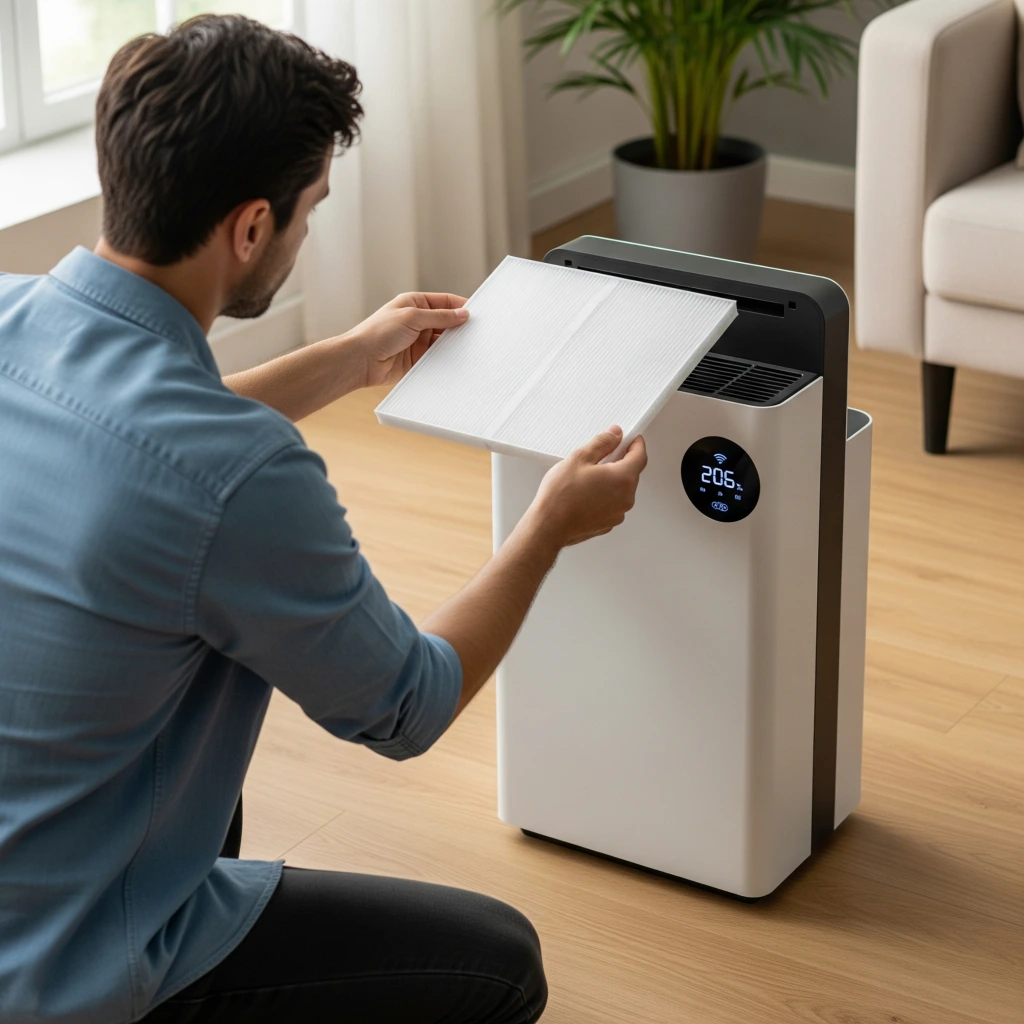
Energy Consumption and Running Costs
When you’re picking out an air purifier for newborn, it’s easy to get caught up in all the fancy features and filter types. But let’s talk about something that really matters long term: how much electricity this thing is going to use and what it’ll cost you to keep it running. You’ll likely have this purifier on pretty much all the time, especially in the early months, so energy efficiency is a big deal.
Think about it running a device 24/7 can add up on your utility bill. Some purifiers are surprisingly power hungry, while others are designed to sip electricity. It’s worth checking the wattage, especially on the higher fan settings, and then doing a quick calculation based on your local electricity rates.
For example, a unit that uses around 70–80 watts on its highest setting might consume about 71 kilowatts annually, which is pretty reasonable. On lower settings, some models, like the Coway Mighty, only draw about 8 watts, making them incredibly economical for continuous use.
Here’s a general idea of what to expect:
- Reduced Setting: Typically uses 2–10 watts.
- Medium Setting: Usually consumes 10–25 watts.
- High Setting: Can range from 25–70 watts or more, depending on the model.
In addition to electricity, don’t overlook the recurring expense of replacement filters. While some filters last a full year, others might need swapping out every 6–8 months. This recurring cost can significantly impact your overall budget for the air purifier for newborn.
It’s not just about the initial purchase price. The ongoing expenses of electricity and filter replacements can really add up over the years. Choosing an energy efficient model with reasonably priced filters will save you money and hassle in the long run, making it a much more practical choice for a best air purifier for newborn.
Levoit Core 300 S



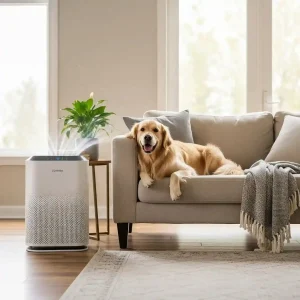
The Levoit Core 300S is a pretty solid choice if you’re looking for an air purifier for newborn. It’s not super fancy, but it gets the job done and has some nice smart features that make life a bit easier. It’s particularly good for smaller to medium sized rooms, like a nursery or a bedroom.
One of the things I really liked about this one is how quiet it is. On its softest setting, it’s barely audible, which is a big deal when you’re trying to get a baby to sleep. It uses a three stage filtration system, which includes a pre filter for bigger stuff like pet hair, a HEPA filter for smaller particles like dust and pollen, and an activated carbon filter to tackle odors. Levoit even offers different filter types, so you can pick one that best suits your needs maybe one that’s better for smoke or pet odors if that’s a concern.
Key Features At A Glance
• Smart App Control via VeSync, Alexa & Google Assistant
• Auto Mode with real time air quality sensing
• Custom Filters for smoke, pets, or allergens
• Quiet Operation ideal for sleep environments
• Compact Design fits easily on a dresser or shelf
| ✅ Pros | ⚠️ Cons |
|---|---|
| Smart app control via VeSync (remote access, scheduling) | Pricier than the Core 300 base model |
| AirSight™ Plus sensor for real-time air quality feedback | Best suited for small to medium rooms |
| Auto mode adjusts fan speed intelligently | Filters are not washable—ongoing replacement cost |
| Quiet operation at night (Sleep Mode) | No dedicated VOC/odor filter included |
| Compact, energy-efficient, and sleek design | No numeric PM2.5 display—uses color ring only |
| 🔍 View Levoit Core 300S on Amazon | |
The app control is a real game changer. Being able to check the air quality from my phone and see the purifier kick into a higher gear when needed gave me a lot of peace of mind. It felt like I was really keeping an eye on the air my baby was breathing.
Keep in mind that while it’s great for nurseries, it’s not really designed for very large open spaces. You’ll get the best performance if you use it in a room that’s not too big. Filter replacements are also something to factor in, usually costing around $30, and they typically need changing every 6 to 8 months depending on how much you use it and the air quality in your home.
Rabbit Air BioGS 2.0

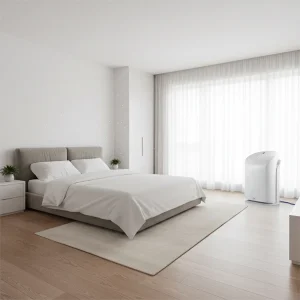
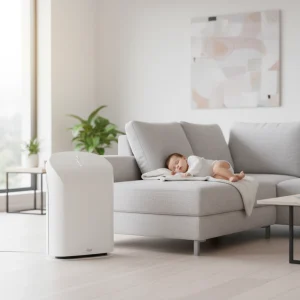
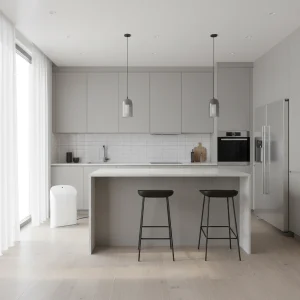
The Rabbit Air BioGS 2.0 is a really solid choice if you’re looking for something that’s both effective and quiet. Its ultra quiet operation is a standout feature, making it ideal for a baby’s room where you don’t want any unnecessary noise disturbing their sleep. Our testers found it so quiet on its minimal setting that they sometimes forgot it was even on, which is pretty impressive.
This purifier utilises a multi stage filtration system, including a HEPA filter that’s designed to capture tiny particles like allergens, dust mites, mold spores, and even viruses. The filter itself is built to last, with some users reporting up to three years of usage under normal conditions. That’s a long time, which can help offset the initial cost.
Speaking of cost, it’s worth noting that the BioGS 2.0 is an investment. Both the unit itself and the replacement filters can be on the pricier side compared to other options. However, the longevity of the filter and the quiet performance might make it worth the splurge for many parents.
Quick Specs At A Glance
• Ultra-Quiet Operation – quieter than a computer
• True HEPA Filtration – captures allergens, mold, viruses
• Long Filter Lifespan – up to 3 years under normal use
• Modern Design – sleek with hidden buttons
• Room Coverage – up to 550 sq. ft.
| ✅ Pros | ⚠️ Cons |
|---|---|
| True HEPA filter removes 99.97% of particles down to 0.3 microns | Lower CFM output—less effective in large rooms |
| Washable pre-filter reduces long-term costs | No smart features or app connectivity |
| Carbon pellet filter for strong odor and gas removal | Premium price for limited coverage area (up to ~250 sq. ft.) |
| Ultra-quiet operation with 5 fan speeds | No real-time air quality display or sensors |
| Sleek design, 5-year warranty, and excellent build quality | No VOC-specific filter or germ sterilization |
| 🛒 View Rabbit Air BioGS 2.0 on Amazon | |
The design is also quite modern and sleek, and we particularly liked that the control buttons are hidden. This is a smart touch for households with curious little ones who might be tempted to press everything they see.
While it doesn’t have a lot of the ‘smart’ features like app control that some newer models boast, its core function of cleaning the air effectively and quietly is where it really shines. If your priority is a peaceful, clean-air environment for your baby, the BioGS 2.0 is definitely worth considering.
Levoit Core 600S
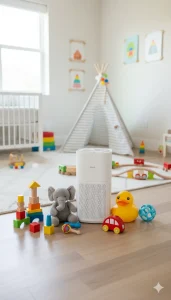
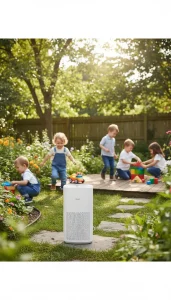
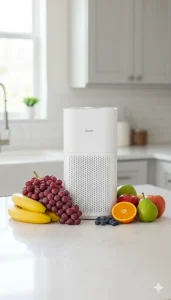

Levoit is a brand that really pops up a lot when you start looking into air purifiers for newborn. They’ve been around for a while, making units that actually work. The Core S line, like the 600S, is a good example of how they manage to pack in cleaning tech and smart features without breaking the bank, which is great if you’re setting up a nursery.
When we tested the Core 600S, it really impressed us with how fast it cleaned up our test space. It cleared out simulated pollutants in about 15 minutes, which is quicker than most we’ve tried. Inside, it’s got a strong fan and a three stage filter system. You get a pre filter for the bigger stuff like dust, a main filter that catches tiny things like mold, bacteria, and viruses, and then activated carbon to deal with smells and those tricky VOCs.
What makes this one particularly good for a baby’s room is its AirSight Plus sensor. This little guy keeps an eye on your air quality all the time. When you put it in Auto Mode, the fan speed automatically adjusts based on what the sensor detects. So, you can just switch it on and feel pretty good knowing your little one is breathing cleaner air.
You can also keep tabs on your home’s air quality right from your phone using the Levoit VeSync app. It’s pretty handy for checking in when you’re not home.
| ✅ Pros | ⚠️ Cons |
|---|---|
| Cleans air in rooms up to 1,580 sq. ft. with 410 CFM CADR | Large footprint—takes up more space than smaller models |
| H13 True HEPA filter + ARC carbon layer for odors and VOCs | No UV sterilization or germicidal features |
| Smart app control, voice assistant support, and Auto Mode | Higher upfront cost and pricier replacement filters |
| Real-time PM2.5 sensor with display and air quality history | Can be noisy at max speed (not ideal for quiet zones) |
| Energy Star certified, ultra-quiet Sleep Mode, and light sensor | No washable filters—maintenance required |
| 🛒 View Levoit Core 600S on Amazon | |
Overall, the Levoit Core 600S is a powerful option that can handle rooms up to around 700 square feet, providing about four air changes per hour. It did very well in our tests, though we did notice a slight rattle on the medium high and high fan speeds that we couldn’t quite fix.
Alen BreathSmart Flex
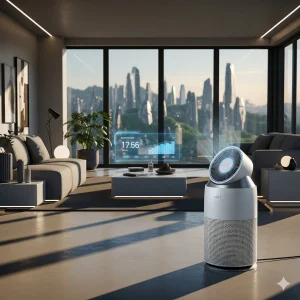
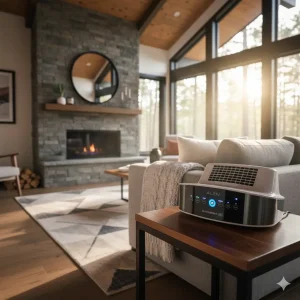
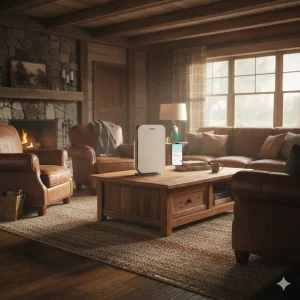
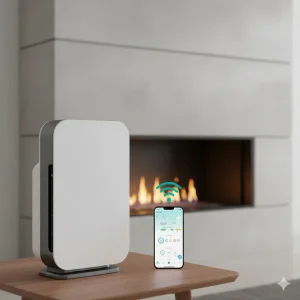
Alen is a brand that’s been around for a while, over 20 years actually, and they make some pretty solid air purifiers for nursery usage. The BreathSmart Flex is a good choice if you want something that works well without a lot of fancy extras that just drive up the price. It’s designed to clean the air in a decent sized room, around 296 square feet, which is usually enough for a nursery or a smaller bedroom.
What’s nice about the Flex is that you can pick different filters depending on what you’re most worried about. They all utilize H13 HEPA, which is great for catching tiny particles, but you can also get filters with more activated carbon if odors or VOCs are a concern. Activated carbon is really good at grabbing onto smells and other airborne gunk.
This nursery ready purifier delivers reliable performance without breaking the bank.
Key Features At A Glance
- Recommended Room Size: Up to 296 sq. ft.
- Filter Type: medical-grade H13 HEPA paired with your choice of activated-carbon insert—Fresh, OdorCell, or Heavy Smoke.
- CADR Ratings: Dust: 208.8 CFM, Smoke: 191 CFM, Pollen: 245.4 CFM
- Noise Levels: Starts at a quiet 35.7 dB on the lowest setting.
- Filter Life: Typically 9–12 months.
| ✅ Pros | ⚠️ Cons |
|---|---|
| H13 True HEPA filter captures allergens, dust, and smoke | No smart features or app connectivity |
| Covers up to 700 sq. ft. with 225 CADR—great for bedrooms | No real-time air quality display or sensors |
| Ultra-quiet operation (39–55 dB) with Sleep Mode | No auto mode or ionizer like the 45i model |
| Energy Star certified—low running cost | Filter subscription required for lifetime warranty |
| Sleek design, intuitive controls, and low maintenance | Higher price than basic models without smart upgrades |
| 🛒 View Alen BreatheSmart FLEX on Amazon | |
One of the standout features is the lifetime warranty they offer, though you usually need to register the product and keep up with filter subscriptions. It’s also pretty energy efficient, which is a plus for keeping running costs down. On the flip side, it doesn’t have any smart features like app control, and the replacement filters can be a bit pricier compared to some other brands.
While it might not have all the bells and whistles of more expensive models, the Alen BreathSmart Flex gets the job done effectively. It’s a reliable option for cleaner air in your air purifier for baby room.
Coway Airmega 200M

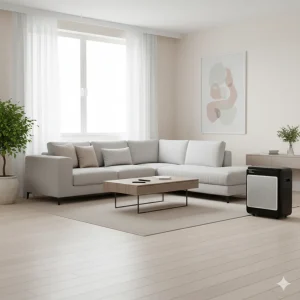

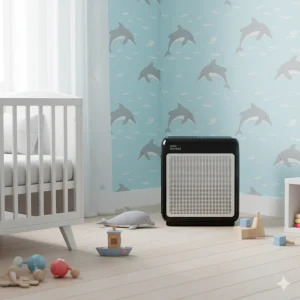
The Coway Airmega 200M is a solid choice if you’re looking for a purifier that balances performance with a relatively compact design. It’s not the smallest unit out there, but it’s definitely not an eyesore either, fitting nicely into most air purifier for nursery décors. This purifier is known for its quiet operation, which is a big plus when you have a little one sleeping.
Its standout asset is a thorough, multi stage filtration setup. It typically includes a pre-filter to catch larger particles like pet hair and dust bunnies, a True HEPA filter for trapping 99.97% of airborne allergens and particles as small as 0.3 microns, and an activated carbon filter to tackle odors. This combination means it’s pretty effective at cleaning the air in a best air purifier for newborn, getting rid of things like dust, pollen, and even lingering smells.
Here’s what to expect at a glance:
- Filtration: pre-filter, True HEPA, activated carbon.
- Coverage Area: Suitable for medium to large rooms (check specific room size recommendations)
- Noise Level: Generally operates at a low decibel range on its lower settings, making it suitable for bedrooms.
- Air Quality Indicator: Features an LED light that changes color to reflect the current air quality, giving you a visual cue.
| ✅ Pros | ⚠️ Cons |
|---|---|
| H13 True HEPA filter captures allergens, dust, and smoke | No smart features or app connectivity |
| Covers up to 700 sq. ft. with 225 CADR—great for bedrooms | No real-time air quality display or sensors |
| Ultra-quiet operation (39–55 dB) with Sleep Mode | No auto mode or ionizer like the 45i model |
| Energy Star certified—low running cost | Filter subscription required for lifetime warranty |
| Sleek design, intuitive controls, and low maintenance | Higher price than basic models without smart upgrades |
| 🛒 View Alen BreatheSmart FLEX on Amazon | |
Auto mode adds real convenience, adjusting settings on its own as air quality changes. The purifier adjusts its fan speed automatically based on the air quality it detects. This means it can ramp up when needed and then quiet down when the air is clean, saving energy and reducing noise. You can find more information on air purifiers for newborn and their characteristics on sites like Coway’s official page.
While it doesn’t have all the fancy app controls of some higher-end models, the Coway Airmega 200M focuses on doing the core job well: cleaning your air effectively and quietly. It’s a reliable workhorse that gets the job done without a lot of fuss, which is exactly what most parents are looking for.
Blueair Blue Pure 411 Auto


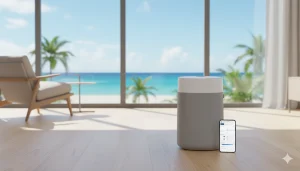
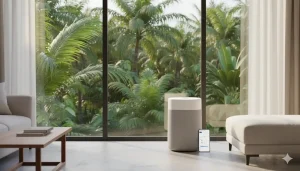
The Blueair Blue Pure 411 Auto is a reliable, no-fuss option for a compact nursery purifier. It’s not overly complicated, which is nice when you’re already dealing with a newborn.
One of the things I really liked about this model is how quiet it is. Even on the higher settings, it’s not going to be blasting noise that’ll wake the baby. It’s designed to be pretty unobtrusive, which is a big win in my book. Plus, the auto mode is handy because it adjusts itself based on the air quality, so you don’t have to constantly fiddle with the settings.
A welcome perk: the pre filter is a washable fabric sleeve you can toss in the laundry, too. It catches the bigger stuff like pet hair and dust bunnies, and you can just toss it in the wash. It means less money spent on replacement filters down the line, which is always a good thing when you’ve got a baby.
It’s also pretty energy efficient, which is something to consider since it’ll likely be running a lot. You’ll also want to keep your power bill from skyrocketing.
Here’s a quick look at what it offers:
- HEPA-type filtration: Captures a good amount of airborne particles.
- Activated carbon filter: Helps with odors and gases.
- Three fan speeds: Manual control if you don’t want to use auto mode.
- Washable pre-filter: Easy to clean and reuse.
| ✅ Pros | ⚠️ Cons |
|---|---|
| Compact and lightweight—ideal for small rooms | Not suitable for large spaces |
| Auto mode adjusts fan speed based on air quality | No app or smart assistant integration |
| HEPASilent™ tech combines electrostatic and mechanical filtration | No PM2.5 display—only LED indicator |
| Customizable pre-filter skirts to match your decor | Falls over easily due to narrow base |
| Energy-efficient and whisper-quiet at low speeds | No timer or remote control features |
| 🛒 View Blueair Blue Pure 411 Auto on Amazon | |
While it’s not the most feature packed purifier out there, especially compared to some of the smart models, it gets the job done effectively for its intended purpose. If you need a reliable air purifier for baby for a nursery or a smaller living space, this one is definitely worth checking out. You can find more details on how different models perform in consumer reports testing.
Filter replacement is usually recommended every six months, depending on your air quality and how much you run it. The cost for replacement filters is pretty standard for this size of unit.
Winix 5500-2
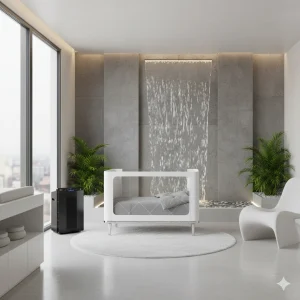

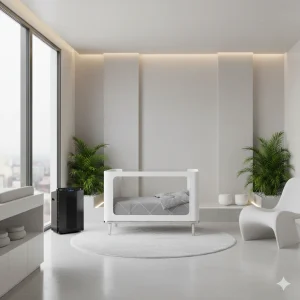
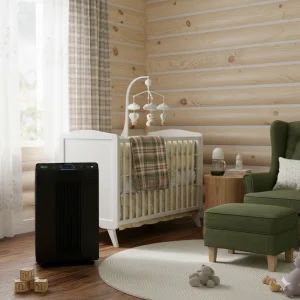
The Winix 5500-2 is a well-regarded nursery purifier that consistently earns high marks from parents. It’s often mentioned as a good option for medium to large rooms, and it comes with a few qualities that make it stand out. For starters, it uses a True HEPA filter, which is what you want for capturing those really tiny particles like dust, pollen, and pet dander. It also has an activated carbon filter layer, which is great for tackling odors, think cooking smells or that lingering pet scent.
One of the things that makes this model a bit different is its PlasmaWave technology. Winix says this technology helps break down airborne pollutants at a molecular level without producing harmful ozone. It’s an optional functionality, so you can turn it off if you prefer.
Key specs at a glance:
- Filter Type: True HEPA, Activated Carbon, Washable Pre-filter
- Coverage Area: Up to 360 sq. ft.
- CADR: 120 (Smoke), 121 (Dust), 117 (Pollen)
- Noise Level: 27.8 dB (Low) to 54.1 dB (High)
| ✅ Pros | ⚠️ Cons |
|---|---|
| True HEPA filter + pellet-based carbon filter for strong odor removal | Only 1-year warranty—shorter than competitors |
| PlasmaWave tech adds extra layer of air cleaning | PlasmaWave may emit trace ozone when active |
| Auto mode, air quality sensor, and remote control included | LED lights can’t be fully disabled—even in Sleep Mode |
| Washable pre-filter and carbon filter reduce long-term costs | Sensor only detects odors—not dust or PM2.5 |
| Excellent CADR (232–246 CFM) for rooms up to 360 sq. ft. | Bulky design—may be harder to place discreetly |
| 🛒 View Winix 5500-2 on Amazon | |
It’s not a ‘smart’ purifier, meaning no app control or Wi-Fi connectivity, but it does have an auto mode. This mode uses a sensor to detect air quality and adjusts the fan speed accordingly. Plus, there’s a display that dims automatically when the room gets dark, which is a nice touch if you’re sensitive to lights at night. The filter replacement indicator is also helpful so you know when it’s time to swap out the filters. Overall, it’s a reliable workhorse for cleaner air.
Dyson Pure Cool TP04


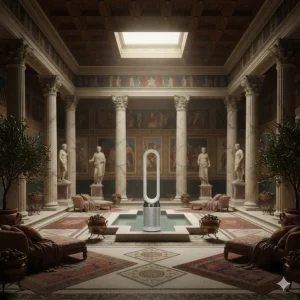

The Dyson Pure Cool TP04 is a bit of a hybrid, acting as both an air purifier for nursery and a fan. It’s got that sleek, bladeless design that Dyson is known for, which is nice because there are no fast spinning parts to worry about around a baby. It uses a HEPA H13 filter, which is pretty good at catching tiny particles like dust, pollen, and pet dander.
One of the standout characteristics is its connectivity. You can control it with an app, which lets you check air quality and adjust settings even when you’re not home. It also oscillates, spreading the purified air around the room. It’s definitely on the pricier side, and it’s a pretty tall unit, so make sure you have the space.
Here’s a quick look at what it offers:
- HEPA H13 Filtration: Captures 99.97 % of particles down to 0.3 microns.
- App Control: Monitor and manage the purifier remotely via the MyDyson app.
- Fan Functionality: Doubles as an oscillating fan for cooling.
- Real-time Air Quality Monitoring: Tracks particulate matter and VOCs.
| ✅ Pros | ⚠️ Cons |
|---|---|
| Bladeless fan design with Air Multiplier™ tech for cooling and circulation | Premium price point compared to similar CADR models |
| 360° sealed HEPA + activated carbon filter removes PM2.5, VOCs, and odors | Filters are not washable—replacement required |
| Real-time air quality display and app control via Wi-Fi | No humidification or heating features (unlike HP series) |
| Auto mode adjusts fan speed based on sensor data | Tall design (41.5″) may not suit compact spaces |
| Voice control via Alexa and Google Assistant | Noisy at max speed—better suited for daytime use |
| 🛒 View Dyson Pure Cool TP04 on Amazon | |
While the Dyson TP04 is a capable purifier with some neat smart features, its size and cost mean it’s not the best fit for every air purifier for baby room. It’s a good option if you value the fan function and app control, and have the budget for it.
Filter replacement is something to keep in mind. The filters are usually around $80 and are recommended to be changed every 6 to 12 months, depending on usage and air quality.
Austin Air HealthMate
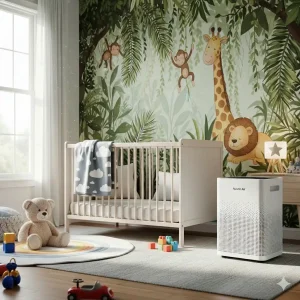
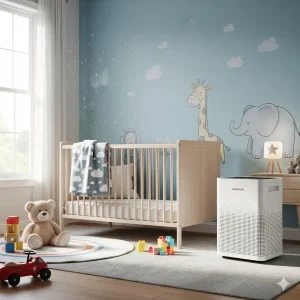


The Austin Air HealthMate is a bit of a workhorse, designed for those who need serious air cleaning power. It’s not the flashiest unit out there, but it gets the job done, and it’s built to last. If you’re looking for something that can handle a larger space or really tackle persistent air quality issues, this one is worth a look.
The HealthMate’s defining feature is its heavy duty filtration. It uses a multi stage approach, typically including a pre filter for larger particles, a substantial amount of activated carbon for odors and chemicals, and a medical grade HEPA filter. This combination means it’s really good at capturing a wide range of airborne contaminants, from dust and pet dander to smoke and even some gases.
- Pre-filter: Catches larger particles like hair and dust bunnies, extending the life of the main filters.
- Activated Carbon Filter: A generous amount of carbon helps to adsorb odors, VOCs, and other chemical pollutants.
- HEPA Filter: Traps 99.97 % of airborne particles as small as 0.3 microns covering allergens, mold spores, and bacteria.
| ✅ Pros | ⚠️ Cons |
|---|---|
| Medical-grade HEPA + 15 lbs of activated carbon and zeolite | No smart features, app control, or air quality display |
| Exceptional VOC, gas, and odor removal—ideal for chemical sensitivities | Heavy unit (45 lbs) and no wheels—harder to move |
| Covers up to 1,500 sq. ft. with 250 CFM airflow | No auto mode or sensor-based adjustments |
| 5-year warranty and 5-year filter life—low maintenance | Noisy at high speed—best used in larger rooms |
| Clinically tested and recommended by FEMA and Red Cross | Industrial look may not suit all home aesthetics |
| 🛒 View Austin Air HealthMate on Amazon | |
When it comes to performance, the HealthMate is known for its high air-cleaning capacity. It’s often recommended for larger rooms or for people with significant sensitivities. The trade-off for this power can be noise, especially on higher settings, so it might not be the best choice if you need absolute silence in the air purifier for baby room. Also, it’s a pretty substantial unit, so make sure you have the space for it.
While the initial cost might seem higher than some other options, consider the long term value. The robust construction and effective filtration mean fewer filter replacements over time compared to some lighter-duty models, potentially saving you money in the long run. Plus, the peace of mind from knowing your baby is breathing cleaner air is pretty significant.
Filter replacement is typically recommended every 2–5 years, depending on usage and air quality, which is a much longer lifespan than many other purifiers on the market. This longevity is a big plus, reducing the hassle and ongoing cost of maintenance.
GermGuardian AC4825

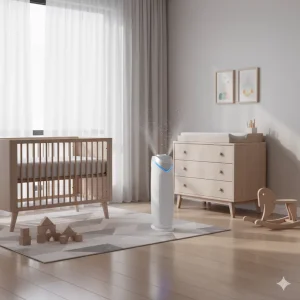
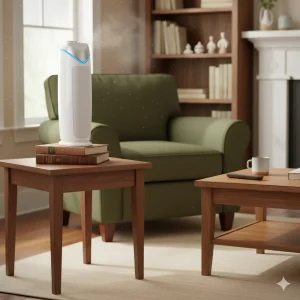

The GermGuardian AC4825 is a pretty solid air purifier for newborn if you’re looking for something that gets the job done without a lot of fuss. It’s not the fanciest unit out there, but it does a good job of cleaning the air in a medium sized room.
It uses a three stage filtration system, which includes a pre filter for larger particles, a HEPA filter for smaller stuff like dust and pollen, and an activated carbon filter to tackle odors. This combination is great for capturing common allergens and keeping your air purifier for baby room smelling fresh.
One thing to note is that the filters typically need replacing every 6 to 8 months, depending on how much you run it. While the initial cost of the unit is reasonable, you’ll want to factor in the ongoing cost of replacement filters.
Here’s a quick look at its specs:
Feature | Specification
Recommended Room Size | 219 sq. ft.
CADR (Dust) | 134 CFM
CADR (Smoke) | 126 CFM
CADR (Pollen) | 154 CFM
Filter Life | 6–8 months
Noise Level (Speed 1) | 38.9 dBA
Noise Level (Speed 3) | 54.5 dBA
| ✅ Pros | ⚠️ Cons |
|---|---|
| True HEPA filter captures 99.97% of airborne particles | Carbon filter is basic—limited odor/VOC removal |
| UV-C light adds germ-killing capability | UV bulb is low wattage and may be ineffective |
| Compact tower design fits easily in small rooms | Covers only up to ~155 sq. ft.—not for large spaces |
| Simple 3-speed control and filter change indicator | No smart features, auto mode, or air quality sensor |
| Affordable price for true HEPA performance | Noisy at low speed (~46.7 dBA) compared to competitors |
| 🛒 View GermGuardian AC4825 on Amazon | |
It’s pretty straightforward to use, with simple controls. You won’t find a lot of fancy smart attributes or app connectivity here, but that also means fewer things to potentially go wrong. It’s a reliable workhorse for cleaner air.
Honeywell HPA300
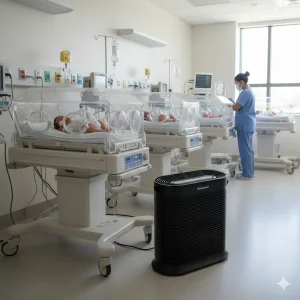
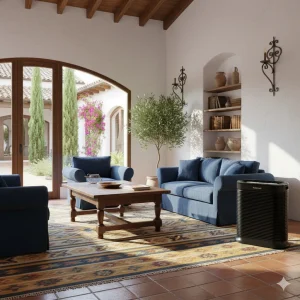
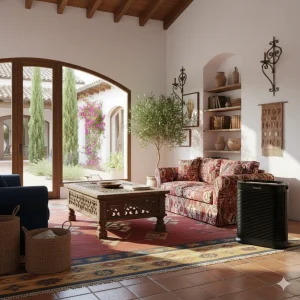
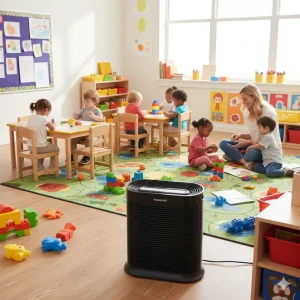
The Honeywell HPA300 is a pretty beefy air purifier for newborn, designed to tackle larger rooms. It uses a True HEPA filter, which is good for capturing those really tiny particles, down to 0.3 microns. It also has an activated carbon pre-filter to help with odors.
When it comes to performance, it does a decent job. However, it’s not exactly quiet. On its highest setting, it can get pretty loud, reaching up to 62 decibels. That’s like having a normal conversation right next to you, which might be a bit much for a air purifier for baby room.
Here’s a quick look at its fan speeds and noise levels:
Speed | Decibels (approx.)
Low | 40 dB
Medium | 53 dB
High | 58 dB
Turbo | 62 dB
| ✅ Pros | ⚠️ Cons |
|---|---|
| High CADR ratings (300+ for smoke, dust, pollen)—great for large rooms | No auto mode or smart features |
| True HEPA filter + activated carbon pre-filter for allergens and odors | No real-time air quality display or sensors |
| Turbo Clean mode for fast purification during allergy season | Can be noisy at highest speed (~59 dB) |
| Touch controls, timer (2–8 hrs), and dimmable panel lights | Bulky design—may not suit minimalist spaces |
| Affordable replacement filters and easy maintenance | Only 1-year warranty—shorter than competitors |
| 🛒 View Honeywell HPA300 on Amazon | |
It’s also a bit of a power user, meaning it uses more electricity than some other models. So, while it cleans the air effectively, you might notice a bump in your energy bill.
One thing to keep in mind is its size. This unit is quite large and might take up a good chunk of space in your room. It’s not exactly a subtle addition to your décor.
Overall, the HPA300 is a capable air cleaner, especially for larger areas, but the noise and energy consumption are definitely points to consider, particularly when you’re looking for something for a best air purifier for newborn.
Final Thoughts on Air Purifier for Newborn Quality
So, you’ve learned a lot about picking the right air cleaner for your little one. Remember, a good HEPA filter is key for catching those tiny particles. Also, try to find one that doesn’t make too much noise, because a sleeping baby is a happy baby (and a happy parent!)
. We looked at a bunch, and the Levoit Core 300S really stood out for its all-around performance, while the Rabbit Air BioGS 2.0 was super quiet. Making sure your baby has clean air to breathe is a big step in keeping them healthy, and hopefully, this guide makes that choice a little easier for you.
👶 Frequently Asked Questions About Air Purifiers for Newborns
What makes an air purifier for newborn good for a baby’s room?
An ideal air purifier for baby rooms should use a HEPA filter to capture tiny particles like dust, allergens, and pet dander. It should operate quietly to avoid disturbing sleep, and features like a child lock and soft nightlight add safety and comfort.
Why is a HEPA filter so important for babies?
HEPA filters remove at least 99.97% of microscopic irritants such as dust, pollen, mold, and bacteria. Since babies have developing lungs, cleaner air helps reduce allergy risks and supports easier breathing.
How loud should an air purifier for newborn be for a nursery?
Choose a quiet air purifier for infants—ideally under 50 decibels, which is about the volume of a soft conversation. This ensures your baby sleeps peacefully without disruptive background noise.
Can an air purifier in the nursery relieve my baby’s stuffy nose?
Yes! A stuffy nose is often caused by airborne particles like dust, pollen, or germs. A HEPA-equipped air purifier for baby rooms helps remove these irritants, making it easier for your newborn to breathe comfortably.
Where is the best place to put an air purifier for newborn in a nursery?
Place the air purifier where airflow isn’t blocked—away from furniture and near sources of dust or odors. Positioning it near a doorway or open space helps it circulate and clean air more effectively.
How often do I need to change the filters, and how much does it cost?
Most air purifiers for newborns require filter changes every 6 to 12 months. Costs vary by brand and model, so check the manufacturer’s guidelines. Factor filter replacement into your budget when choosing the best purifier for your baby.

